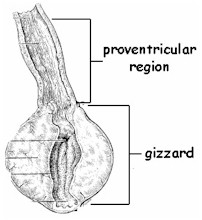Tag: Prolactin
-
The PVN Powerhouse: How the Paraventricular Nucleus Rules Hormone Secretion
Hold onto your hypothalamus, folks! We’re about to dive into the wild world of the Paraventricular Nucleus (PVN), where tiny cells pack a mighty hormonal punch! Picture this: deep in the brain’s control center, the hypothalamus, sits the PVN – a cluster of cells that’s like the body’s own hormone factory. But we’re not talking…
-

The lactating birds and the bees (gastrin, pepsin, etc)
Crop milk is a secretion from the lining of the crop of parent birds that is regurgitated to young birds. It is found among all pigeons and doves where it is referred to as pigeon milk. An analog to crop milk is also secreted from the esophagus of flamingos and the male emperor penguin. Description Crop milk bears little physical resemblance to mammalian milk. Crop milk is a…
-

Columbidae anatomy and physiology notes
Overall, the anatomy of Columbidae is characterized by short legs, short bills with a fleshy cere, and small heads on large, compact bodies. Like some other birds, the Columbidae have no gall bladders. Some medieval naturalists concluded they have no bile (gall), which in the medieval theory of the four humours explained the allegedly sweet disposition of doves. In fact, however, they do have bile (as Aristotle had…
-

A syrinx is a fluid-filled neuroglial cavity within the spinal cord, in the brain stem, or in the nerves of the elbow
A syrinx is a rare, fluid-filled neuroglial cavity within the spinal cord (syringomyelia), in the brain stem (syringobulbia), or in the nerves of the elbow, usually in a young age. Presentation Symptoms usually begin insidiously between adolescence and age 45. Syringomyelia develops in the center of the spinal cord, causing a central cord syndrome. Pain and temperature sensory deficits occur early but may…
-

Calcitriol
Medical use Adverse effects Mechanism of action Calcitriol increases blood calcium levels ([Ca2+]) by: Biosynthesis and its regulation Interactive pathway map Metabolism History Names External links Hormones Vitamins (A11) Drugs used for psoriasis (D05) Vitamin D receptor modulators Portal: Medicine Categories: From Wikipedia where this page was last updated August 4, 2022
-
Somatostatin
Not to be confused with Somatocrinin or Somatomedin. Somatostatin, also known as growth hormone-inhibiting hormone (GHIH) or by several other names, is a peptide hormone that regulates the endocrine system and affects neurotransmission and cell proliferation via interaction with G protein-coupled somatostatin receptors and inhibition of the release of numerous secondary hormones. Somatostatin inhibits insulin and glucagon secretion. “somatostatin”. Encyclopædia Britannica. Encyclopædia Britannica Online. Encyclopædia Britannica Inc., 2016. Web. 04 mag. 2016…
-

Calcitonin
Calcitonin is a 32 amino acid peptide hormone secreted by PARAFOLLICULAR CELLS (also known as C cells) of the thyroid (or endostyle) in humans and other chordates in the ultimopharyngeal body. It acts to reduce blood calcium (Ca2+), opposing the effects of PARATHYROID HORMONE (PTH). Its importance in humans has not been as well established as its importance in other animals, as its function is usually not significant in the…
-
Prolactin receptor modulators
Prolactin Agonists An agonist is a chemical that activates a receptor to produce a biological response. Receptors are cellular proteins whose activation causes the cell to modify what it is currently doing. In contrast, an antagonist blocks the action of the agonist, while an inverse agonist causes an action opposite to that of the agonist. Etymology: From the Greek αγωνιστής (agōnistēs), contestant; champion; rival < αγων (agōn), contest, combat; exertion, struggle…
-

Prolactin (PRL)
In mammals, prolactin is associated with milk production; in fish it is thought to be related to the control of water and salt balance. Prolactin also acts in a cytokine-like manner and as an important regulator of the immune system. It has important cell cycle-related functions as a growth-, differentiating- and anti-apoptotic factor. As a growth factor,…
-
Leydig cells aka interstitial cells of the testes and interstitial cells of Leydig
Leydig cells, also known as interstitial cells of the testes and interstitial cells of Leydig, are found adjacent to the seminiferous tubules in the testicle and produce testosterone in the presence of luteinizing hormone (LH).[1][2] They are polyhedral in shape and have a large, prominent nucleus, an eosinophiliccytoplasm, and numerous lipid-filled vesicles.[3] Structure The mammalian Leydig cell is a polyhedral epithelioid cell with a single eccentrically located ovoid nucleus.…
-
Haldol: The Grim Reaper’s Sidekick
Haloperidol, better known as Haldol, is not just a drug—it’s a cultural artifact of medicine’s darker corners. It has worn many hats: psychiatric savior, hospice workhorse, veterinary tranquilizer, and even a lurking specter in the shadowy world of death cocktails. This report dives deep into the multifaceted (and occasionally unsettling) life of Haldol, from its…
-
Human placental lactogen (hPL)
Human placental lactogen (hPL), also called human chorionic somatomammotropin (HCS), is a polypeptideplacental hormone, the human form of placental lactogen (chorionic somatomammotropin). Its structure and function are similar to those of human growth hormone. It modifies the metabolic state of the mother during pregnancy to facilitate the energy supply of the fetus. hPL has anti-insulin properties. hPL is a hormone secreted by the syncytiotrophoblast during pregnancy. Like human growth hormone, hPL…
Recent Posts
- 🧬 Disease Table with Low Sodium Connection
- 🧂 Sodium Reduction and Sodium Replacement: A History of Reformulation and Exploding Diseases, Including Many Diseases Unheard of Before Deadly Sodium Policies
- 🧂 The DEADLY 1500 mg Sodium Recommendation predates the WHO’s formal global sodium reduction push by nearly a decade (and it’s even worse than that)
- 🧬 What Is Beta-Glucuronidase?
- When Sugar Was Salt: Crystalline Confusion and the Covenant of Sweetness
Tags
ADAM ASPARTAME Birds Blood Bones Brain Bugs Cancer Columba Cows crystallography Death Death cults Eggs Etymology Gastrin Gold Growth hormone History Hormones Insulin Liver Mere Perplexity Metal Monkey Business Mythology Paracetamol Plants Poison Pregnancy Protein Religion Reproduction Rocks Salt Slavery Snakes Sodium the birds and the bees Thiocyanate Tobacco Tylenol Underworld Venom zinc